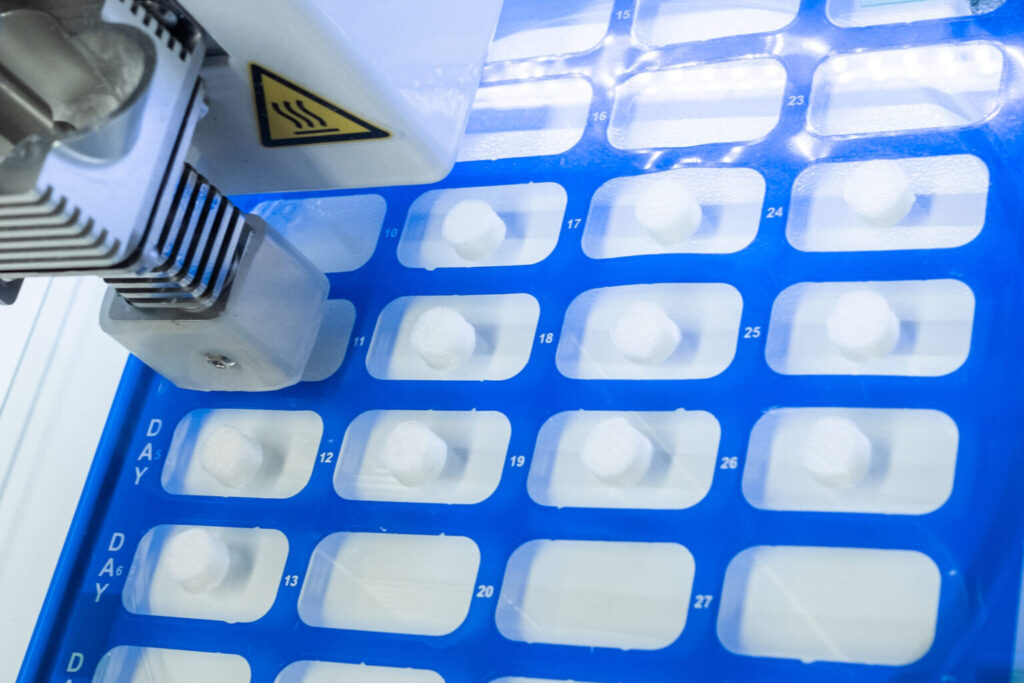
The Global 3D Printed Drugs Industry is on track for a remarkable surge, fueled by advancements in technology and growing demand for personalized medicine solutions. According to a recent analysis by Future Market Insights (FMI), the market is expected to reach a staggering US$742.88 million by 2032, reflecting a Compound Annual Growth Rate (CAGR) of 9.2% between 2022 and 2032. This significant growth follows an initial market value of US$307.54 million estimated for 2022.
The growing demand for 3D-printed medications is largely driven by their large-scale uses in the healthcare industry, which coincides perfectly with the rising frequency of chronic illnesses globally. This trend is likely to accelerate throughout the projection period, highlighting the industry’s strong growth trajectory.
One of the key factors contributing to the surge in demand is the quick solubility and customizable nature of 3D-printed drugs. Leveraging powder bed inkjet printing technology, these drugs are manufactured by layering the components in a format analogous to traditional 3D printing. This innovative production method results in medications that are not only easier to swallow but also hold significant advantages for individuals dealing with dysphagia.
Request Sample Report
https://www.futuremarketinsights.com/reports/sample/rep-gb-2336
Moreover, 3D printing has the potential to speed up the arrival of customized pharmaceuticals or the development of therapeutic blends. With the help of 3D printing, medications could be personalized for each patient, which will likely be more effective than batch-produced medications as they would be produced individually with consideration for that patient’s medical history. All of these considerations aid the growth of the Global 3D Printed Drugs Industry during the forecast period.
“A surge in the demand for customized medications will fuel the global growth of the Global 3D Printed Drugs Industry over the forecast period,” says an FMI analyst.
Global 3D Printed Drugs Industry Key Takeaways:
- The inkjet printer technology segment will hold 24% of the 3D printed drugs market share by the end of 2022.
- The hospitals and clinics end-user segment will own about 45% of the overall market share.
- In 2022, the 3D-printed drugs market in North America will account for 31.1% of the total market share.
- Europe’s 3D drug printing market will hold 29.9% of the market share in 2022.
- Immense potential for 3D printed drugs research will drive the Asia Pacific market to hold 27% of the overall market share in 2022.
Ask An Analyst
https://www.futuremarketinsights.com/ask-question/rep-gb-2336
Global 3D Printed Drugs Industry Competitive Landscape
Hewlett Packard Caribe, Merck, Cycle Pharmaceuticals, AstraZeneca, Aprecia, Osmotica Pharmaceuticals, Aprecia Pharmaceuticals LLC Extend Biosciences, Bioduro, Affinity Therapeutics, GlaxoSmithKline Plc, and FabRx Ltd. among others are some of the major players in the Global 3D Printed Drugs Industry profiled in the full version of the report.
Key market players are focusing on product development and new product launches to meet the growing demand. These organizations also employ strategic partnership and collaboration tactics to gain a competitive advantage.
More Insights into Global 3D Printed Drugs Industry Report
In its latest report, FMI offers an unbiased analysis of the Global 3D Printed Drugs Industry, providing historical data from 2017 to 2021 and forecast statistics for 2022 to 2032. To understand the global market potential, growth, and scope, the market is segmented based on the dosage form (3D printed tablets, 3D printed capsules, 3D printed multi-drug implants, 3D printed nanoparticles, 3D printed solutions, other 3D printed drug dosage forms), technology (inkjet 3D printed drugs, direct write 3D printed drugs, zip dose 3D printed drugs, thermal inkjet 3D printed drugs, 3D printed drugs based on fuel deposition modeling, powder bed 3D printed drugs, stereolithography (SLA) 3D printed drugs, semi-solid extrusion (SSE) 3D printed drugs), and region.
According to the latest FMI reports, based on segmentation, the inkjet printer technology will gain momentum over the forecast period. This segment will likely account for 24% of the Global 3D Printed Drugs Industry share in 2022. Owing to technological advancement inkjet printers are easier and convenient to use. In terms of end use, hospitals and clinics are expected to be major contributors to the overall growth of the target market As easy installation and less waste fasten up the manufacture of 3D printed drugs in hospitals and clinics, these end users are predicted to hold 45% of the overall market share.
Based on region, the 3D-printed drugs market in North America will exhibit impressive growth during 2022-2032. Increasing incidences of chronic diseases, an aging population, and access to a well-established healthcare infrastructure are some of the factors that drive the target market in this region. Thus, the 3D-printed drugs market in North America will account for 31.1% of the total market share in 2022. Besides North America, Europe, and the Asia Pacific regions, too, will register considerable 3D printed drugs market growth during the forecast period.
Request Customization
https://www.futuremarketinsights.com/customization-available/rep-gb-2336
Global 3D Printed Drugs Industry Key Companies Profiled
- Hewlett Packard Caribe
- Merck
- Cycle Pharmaceuticals
- AstraZeneca
- Aprecia
- Osmotica Pharmaceuticals
- Aprecia Pharmaceuticals LLC
- Extend Biosciences
- Bioduro
- Affinity Therapeutics
- GlaxoSmithKline Plc
- FabRx Ltd
Key Segments Covered in the Global 3D Printed Drugs Industry Analysis
by Dosage Form:
- 3D Printed Tablets
- 3D Printed Capsules
- 3D Printed Multi Drug Implants
- 3D Printed Nanoparticles
- 3D Printed Solutions
- Other 3D Printed Drug Dosage Forms
by Technology:
- Inkjet 3D Printed Drugs
- Direct Write 3D Printed Drugs
- Zip Dose 3D Printed Drugs
- Thermal Inkjet 3D Printed Drugs
- 3D Printed Drugs based on Fused Deposition Modeling
- Powder Bed 3D Printed Drugs
- Stereo Lithography (SLA) 3D Printed Drugs
- Semi Solid Extrusion (SSE) 3D Printed Drugs
Author
Sabyasachi Ghosh (Associate Vice President at Future Market Insights, Inc.) holds over 12 years of experience in the Healthcare, Medical Devices, and Pharmaceutical industries. His curious and analytical nature helped him shape his career as a researcher.
Identifying key challenges clients face and devising robust, hypothesis-based solutions to empower them with strategic decision-making capabilities come naturally to him. His primary expertise lies in Market Entry and Expansion Strategy, Feasibility Studies, Competitive Intelligence, and Strategic Transformation.
Holding a degree in Microbiology, Sabyasachi has authored numerous publications and has been cited in journals, including The Journal of mHealth, ITN Online, and Spinal Surgery News.
About Future Market Insights (FMI)
Future Market Insights, Inc. (ESOMAR certified, recipient of the Stevie Award, and a member of the Greater New York Chamber of Commerce) offers profound insights into the driving factors that are boosting demand in the market. FMI stands as the leading global provider of market intelligence, advisory services, consulting, and events for the Packaging, Food and Beverage, Consumer Technology, Healthcare, Industrial, and Chemicals markets. With a vast team of over 400 analysts worldwide, FMI provides global, regional, and local expertise on diverse domains and industry trends across more than 110 countries.
Contact Us:
Future Market Insights Inc.
Christiana Corporate, 200 Continental Drive,
Suite 401, Newark, Delaware – 19713, USA
T: +1-845-579-5705
For Sales Enquiries: sales@futuremarketinsights.com
Website: https://www.futuremarketinsights.com
LinkedIn| Twitter| Blogs | YouTube


